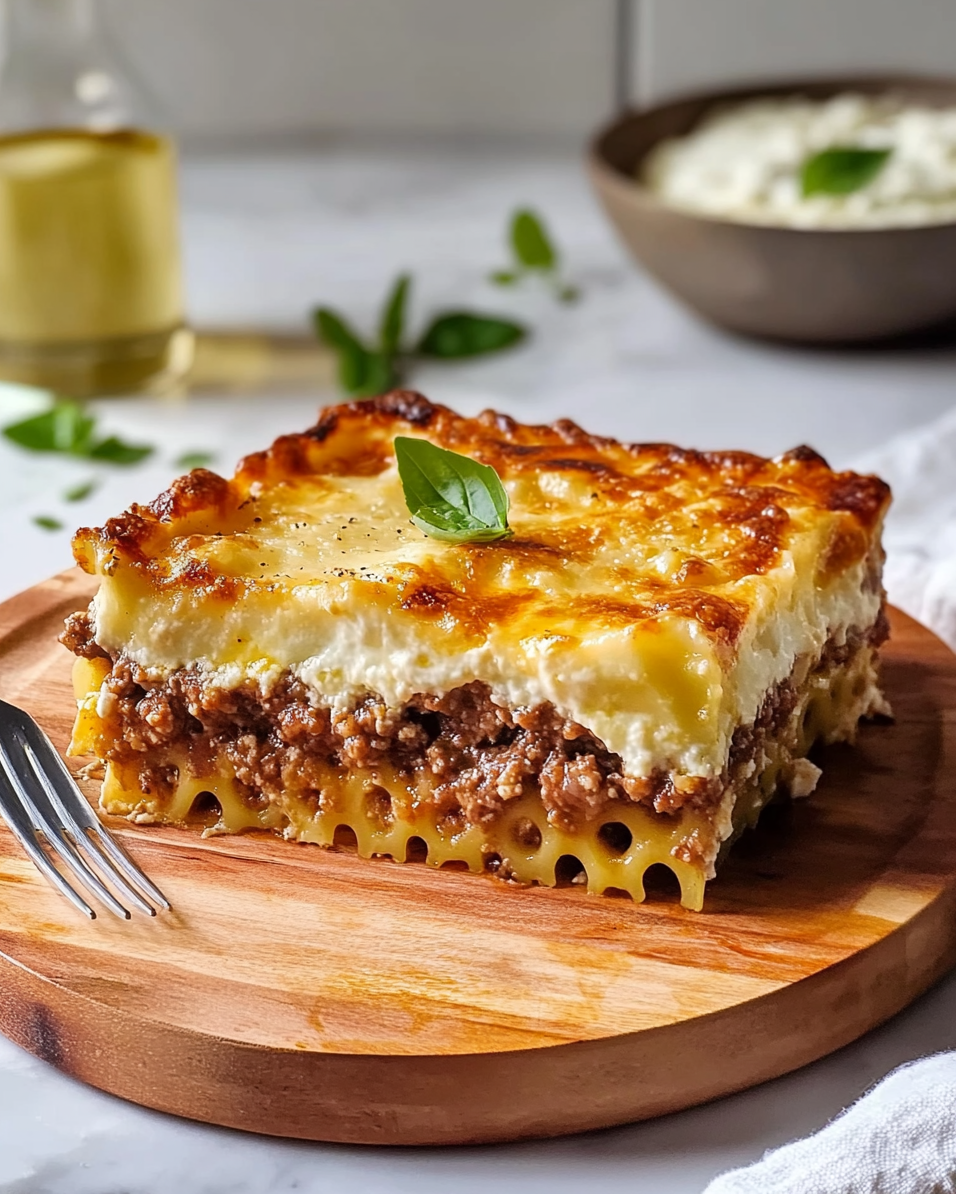Pastitsio is the ultimate Greek comfort food, featuring layers of tender pasta, savory ground beef spiced with cinnamon, and a luscious, creamy béchamel sauce. The dish is baked until the top is golden brown and bubbly, creating a crispy crust that perfectly contrasts with the soft layers beneath.
This traditional Greek dish is a crowd-pleaser and a fantastic choice for family gatherings or weeknight meals. Its warming flavors, brought to life with aromatic spices like cinnamon and nutmeg, make it both familiar and exotic. Whether you’re a fan of baked pasta or just love Mediterranean cuisine, Pastitsio is sure to satisfy.
Full Recipe:
- 1 pound dry ziti pasta
- 1 tablespoon olive oil
- 1 large onion, chopped
- 2 cloves garlic, minced
- 1 1/2 pounds lean ground beef
- 1/4 teaspoon ground cinnamon
- 1/4 teaspoon ground nutmeg
- 1/4 teaspoon ground allspice
- 1 (15-ounce) can tomato sauce
- 1 (6-ounce) can tomato paste
- 1/2 cup red wine
- 2 eggs, beaten
- 1 cup grated Parmesan cheese, divided
- 1/2 cup butter
- 1/2 cup all-purpose flour
- 3 cups milk
- Salt and pepper to taste
Directions:
- Preheat oven to 350°F (175°C). Grease a 9×13-inch baking dish.
- Bring a large pot of salted water to a boil. Add ziti and cook until al dente, about 8 minutes. Drain and set aside.
- Heat olive oil in a large skillet over medium heat. Add onion and garlic, cooking until soft. Stir in ground beef, cinnamon, nutmeg, and allspice, and cook until beef is browned.
- Stir in tomato sauce, tomato paste, and red wine. Simmer for 20 minutes, stirring occasionally.
- In a separate saucepan, melt butter over medium heat. Stir in flour and cook for 1-2 minutes. Gradually whisk in milk, cooking until thickened. Remove from heat and season with salt and pepper. Allow the sauce to cool slightly, then whisk in the eggs.
- Mix half of the Parmesan cheese with the pasta, and spread half of the pasta mixture in the prepared baking dish. Pour the meat sauce over the pasta layer, then cover with the remaining pasta.
- Pour the béchamel sauce over the top and sprinkle with the remaining Parmesan cheese.
- Bake in the preheated oven for 50-60 minutes, until the top is golden and bubbly. Let stand 10 minutes before serving.
Prep Time: 20 minutes | Cooking Time: 60 minutes | Total Time: 1 hour 20 minutes
Kcal: 420 kcal | Servings: 8 servings
Pastitsio is a traditional Greek comfort dish that has been loved by families for generations. It shares similarities with Italian lasagna but has its own unique Mediterranean twist. The dish consists of layers of pasta, typically ziti or penne, combined with a flavorful meat sauce that’s subtly spiced with cinnamon, nutmeg, and allspice—aromas that give it a warm, homey feel. The dish is then crowned with a rich and creamy béchamel sauce, which turns golden and bubbly when baked.
The origins of Pastitsio can be traced back to ancient Greece, where various versions of layered casseroles were enjoyed. The modern version that we know today, with its signature béchamel topping, is influenced by French cuisine, particularly due to the influence of French chefs on Greek aristocracy during the 19th century. It’s a popular dish served at family gatherings, holidays, and special occasions, though it’s simple enough to enjoy as a cozy weeknight meal.
Variations and Serving Suggestions:
- Variations:
- Vegetarian Pastitsio: Replace the meat with sautéed vegetables like mushrooms, zucchini, or eggplant.
- Gluten-Free: Use gluten-free pasta and substitute flour in the béchamel with a gluten-free alternative.
- Healthier Option: Swap ground beef for ground turkey or chicken, and use whole wheat pasta for added fiber.
- Serving Suggestions:
- Pastitsio is traditionally served with a simple side salad of cucumbers, tomatoes, and red onions, dressed with olive oil and oregano.
- Pair the dish with a glass of robust red wine such as a Greek Xinomavro or Cabernet Sauvignon, which complements the rich flavors of the meat and béchamel sauce.
- Leftovers are perfect for reheating, as the flavors deepen and meld together even more.
Cultural Significance:
Pastitsio is not just a meal; it’s a reflection of Greek culinary traditions and a reminder of how food connects families. It’s often served during holidays like Easter or at family Sunday dinners, making it a dish filled with memories for many Greek households. Its hearty nature and the combination of familiar pasta with distinct Mediterranean spices make it appealing even to those new to Greek cuisine.
Tips for the Perfect Pastitsio:
- Spice it Right: The cinnamon and nutmeg are essential to capturing the authentic Greek flavor profile, so don’t skip or skimp on them.
- Let it Rest: After baking, allow the dish to rest for at least 10 minutes before serving. This helps the layers set and makes it easier to slice.
- Make Ahead: You can assemble Pastitsio ahead of time, refrigerate it, and bake it right before serving. This makes it a great option for entertaining or prepping meals in advance.
What is Pastitsio?
Pastitsio (pronounced pa-STEE-tsee-oh) is one of Greece’s most iconic and beloved comfort foods. It’s a layered baked pasta dish, somewhat similar to Italian lasagna but with distinct flavors and textures that set it apart. What makes Pastitsio truly unique is the combination of pasta, spiced meat sauce, and a rich béchamel topping. The result is a hearty, savory, and indulgent dish that’s perfect for family meals, celebrations, and special gatherings.
Traditionally made with tubular pasta such as ziti or penne, ground meat, and a flavorful tomato sauce, Pastitsio’s signature component is the béchamel sauce. This creamy, buttery sauce is poured generously over the layers of pasta and meat before baking, creating a golden, bubbly crust that makes each bite irresistibly smooth and rich.
Historical Background of Pastitsio
The origins of Pastitsio are deeply rooted in Greek and Mediterranean history, but its name actually comes from the Italian word “pasticcio,” which refers to a type of pie or casserole. In ancient Greece, various layered dishes with meat and pasta were prepared, but the modern version of Pastitsio with béchamel sauce emerged during the late 19th and early 20th centuries.
Nikolaos Tselementes, a Greek chef famous for refining Greek cuisine by introducing French culinary techniques, is often credited with creating the modern Pastitsio. Tselementes introduced the French béchamel sauce, elevating the dish and giving it the rich, creamy topping that has become its hallmark.
Key Ingredients and Flavor Profile
Pastitsio’s flavor profile is both rich and aromatic. Unlike traditional Italian baked pasta dishes, Pastitsio has a distinctive combination of Mediterranean spices that give it a signature taste. Here’s a breakdown of the key ingredients:
- Pasta: Traditionally, tubular pasta like ziti or penne is used. The pasta layer is often mixed with a little cheese and eggs to bind it.
- Ground Meat: Ground beef is the most common choice, though lamb or a mix of both can be used. The meat is spiced with warm Mediterranean flavors, including cinnamon, nutmeg, and allspice, which give it an almost sweet, aromatic undertone.
- Tomato Sauce: The meat is simmered with tomato sauce and sometimes red wine, giving the dish a deep, rich flavor.
- Béchamel Sauce: The creamy béchamel, made from butter, flour, and milk, is what sets Pastitsio apart from other baked pasta dishes. It’s thickened to perfection and adds a velvety smooth texture to the top layer.
- Cheese: Grated Parmesan or Kefalotyri, a traditional hard Greek cheese, is sprinkled over the béchamel for an extra golden, crispy topping.
Cultural Importance of Pastitsio in Greece
Pastitsio holds a special place in Greek culinary culture. It’s a dish that brings families together, often served at festive occasions, holidays like Easter, and large gatherings. It’s a dish made with love and patience, symbolizing Greek hospitality and the importance of sharing meals with loved ones.
In Greece, you’ll often find Pastitsio served as part of a larger meal, accompanied by Greek salad, fresh bread, and sometimes a side of tzatziki or roasted vegetables. Its versatility allows it to fit in both casual and formal dining settings.
Variations of Pastitsio
While the classic version of Pastitsio is well-loved, there are numerous variations that allow you to tailor the dish to different dietary preferences or regional traditions:
- Vegetarian Pastitsio: Replace the meat with vegetables like mushrooms, eggplant, or zucchini. You can also add lentils for a protein-rich alternative. The key is to maintain the layers and balance the flavors with spices.
- Vegan Pastitsio: To make a vegan version, substitute the meat with plant-based protein like lentils or a vegan ground meat alternative. The béchamel can be made using almond or oat milk, and flour as a thickener, along with olive oil or vegan butter.
- Pork or Lamb: In some regions of Greece, lamb or pork is used instead of beef, giving the dish a richer, heartier flavor. Lamb Pastitsio is particularly popular in areas where lamb is a staple part of the local diet.
- Healthier Options: For a lighter version, use ground turkey or chicken instead of beef, and whole wheat pasta for added fiber. Some versions also incorporate low-fat milk in the béchamel sauce to reduce the calorie content.
Tips for Making Perfect Pastitsio
- Don’t Rush the Béchamel: Achieving the perfect texture for your béchamel is essential. It should be thick but smooth. Let it cool slightly before whisking in the eggs to prevent them from scrambling.
- Season Generously: The spices are what give Pastitsio its signature flavor. Make sure to season the meat sauce well with cinnamon, nutmeg, and allspice. These spices add warmth and complexity to the dish.
- Layer Properly: When layering the pasta, meat sauce, and béchamel, make sure the layers are even. This ensures every bite gets a little bit of everything.
- Rest Before Serving: Once out of the oven, let the Pastitsio sit for 10-15 minutes. This helps the layers to firm up, making it easier to cut and serve neatly.
- Reheating: Pastitsio is one of those dishes that tastes even better the next day. If reheating leftovers, do so in the oven to retain the crispiness of the béchamel topping.
How to Serve Pastitsio
Pastitsio is a substantial dish, so it pairs well with lighter sides. Here are some classic serving ideas:
- Greek Salad: A simple side of Greek salad, with cucumbers, tomatoes, red onions, Kalamata olives, and feta cheese, dressed in olive oil and oregano, perfectly complements the richness of Pastitsio.
- Tzatziki: This yogurt-based dip with garlic, cucumbers, and fresh herbs adds a refreshing and tangy element to the meal.
- Roasted Vegetables: Roasted Mediterranean vegetables like eggplant, zucchini, or bell peppers are a great side to serve alongside.
- Wine Pairing: Greek wines such as Xinomavro, a red wine with rich flavors, or Assyrtiko, a crisp white wine, make excellent pairings for Pastitsio.
Fun Fact
Pastitsio is often referred to as “Greek lasagna” by many, but its flavor profile is much more nuanced. The use of cinnamon and nutmeg in the meat sauce is what sets it apart from Italian counterparts, giving it that unique and recognizable taste that’s so beloved in Greece.
Conclusion
Whether you’re hosting a family gathering or looking for a comforting meal to enjoy on a chilly evening, Pastitsio delivers with its creamy béchamel topping, hearty meat sauce, and tender pasta. It’s a perfect fusion of flavors and textures that represents the heart of Greek home cooking. This dish will surely become a favorite for anyone who loves Mediterranean cuisine!






